In normal practice, emphasis is given to the polishing of dentures for aesthetic reasons only. Polishing is one of the methods that aides in maintenance of prosthesis hygiene, by enhancing the reduction of Candidal colonization. Polishing of denture surfaces results in reduction in surface free energy, which can directly affect the adherence of microorganisms [1]. Surface characteristics such as microporosities and roughness increase surface free energy, that may cause the dentures to harbour microorganisms. There is only sparse literature on the effect of polishing steps on the Candidal adherence on denture base material.
Hence, this study was conducted to assess different finishing and polishing procedures which reduced surface irregularity to produce a smooth surface and their effect on Candidal adherence.
Material and Methods
This in vitro study was carried out in following sequence:
Specimen fabrication.
Finishing and polishing.
Adherence assay.
1. Specimen Fabrication
A stainless steel mould was used to fabricate wax specimens of dimension10 x 10 x 3 mm3 [2,3]. The mould had an upper plate, a spacer plate and lower plates with aligning pins. The spacer plate which was of 3mm thickness had 8 square perforations. A total of 48 specimens were fabricated [Table/Fig-1 and 2].
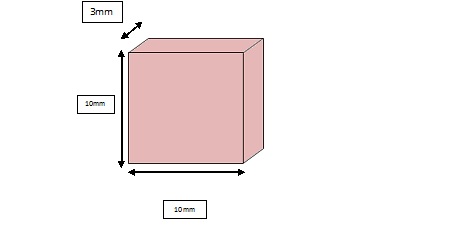
Specimens before polishing

Grouping of Specimens:
Specimens were divided into four groups which had 12 specimens each.
Each of these groups was grouped as per the exposure to different finishing and polishing procedures, except control Group A which had unpolished specimens.
2. Polishing Procedure which was Employed to Polish the Specimen
A wooden jig was fabricated, where specimens were fixed and mechanically polished, as the specimens were very small to be held in the hands. The speed of abrasion was standardized to 1500 rpm3, load under which specimens were abraded was standardized to 400 gram [2] and time for which the specimens were abraded was standardized to 90 seconds [2].
First, the specimens which had to be polished were placed over a glass surface, with the surface which had to be polished facing towards glass. This was done to make sure that all surfaces of specimens were at the same level. Then, all the specimens were attached to a wooden jig at once by using cyanoacrylate glue, making sure that all surfaces were touching the glass surface. Now, the surfaces of the attached specimens which had to be polished faced upwards. This was done to make sure that the surfaces of all the specimens which had to be polished were at the same level, which could help abrasive agents to equally finish and polish specimens at the same time [Table/Fig-3].
Specimen after polishing attached to wooden jig
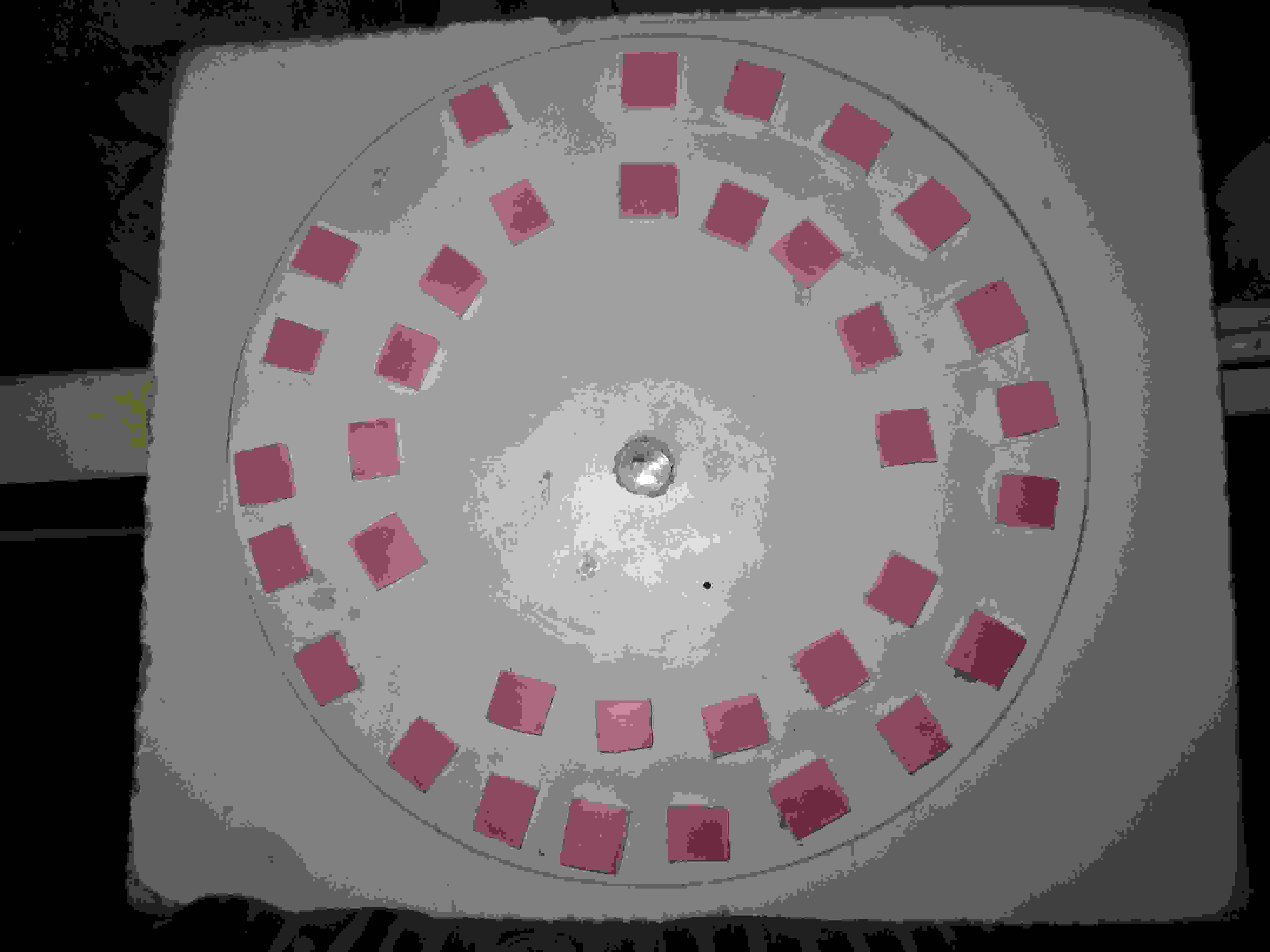
The finishing protocol which was used in the study was: [1,4].
Demarcated specimens which were finished by using sand papers of (320/400/600) grits which were used progressively.
Demarcated specimens which were finished by using sand papers of (320/400/600) grits, followed by polishing with pumice slurry.
Demarcated specimens which were finished by using sand papers of (320/400/600) grits which were used progressively, followed by polishing with pumice slurry and rouge.
Then, the specimens were numbered before the adherence assay was done, to check for the adherence of Candida albicans.
Before beginning with the adherence assay, an yeast suspension was prepared.
Preparation of Yeast Suspension
Candida albicans strains were incubated in Sabouraud’s broth which was supplemented with sucrose at 370C for 24 hours. Candidal growth was harvested after 24 hours by centrifugation. The pellet which resulted from centrifugation was washed twice in phosphate buffered saline solution. The yeast cells were enumerated with McFarland’s unit which was diluted in phosphate buffered saline solution to 107 cells/ml.
Adherence Assay
All the specimens were inoculated with 20 ml of yeast suspension and they were placed in a sterile petri dish and were incubated for 1 hour. Then, the specimens were washed twice by gentle agitation in phosphate buffered saline for 1 minute and they were air dried. Adherent yeast cells were fixed and stained. All the stained specimens were examined under a microscope [5]. Adherent yeast cells in 30 fields of view (0.25 mm2 per field) were expressed as yeast cells/mm2 of specimen [Table/Fig-4 and 5].
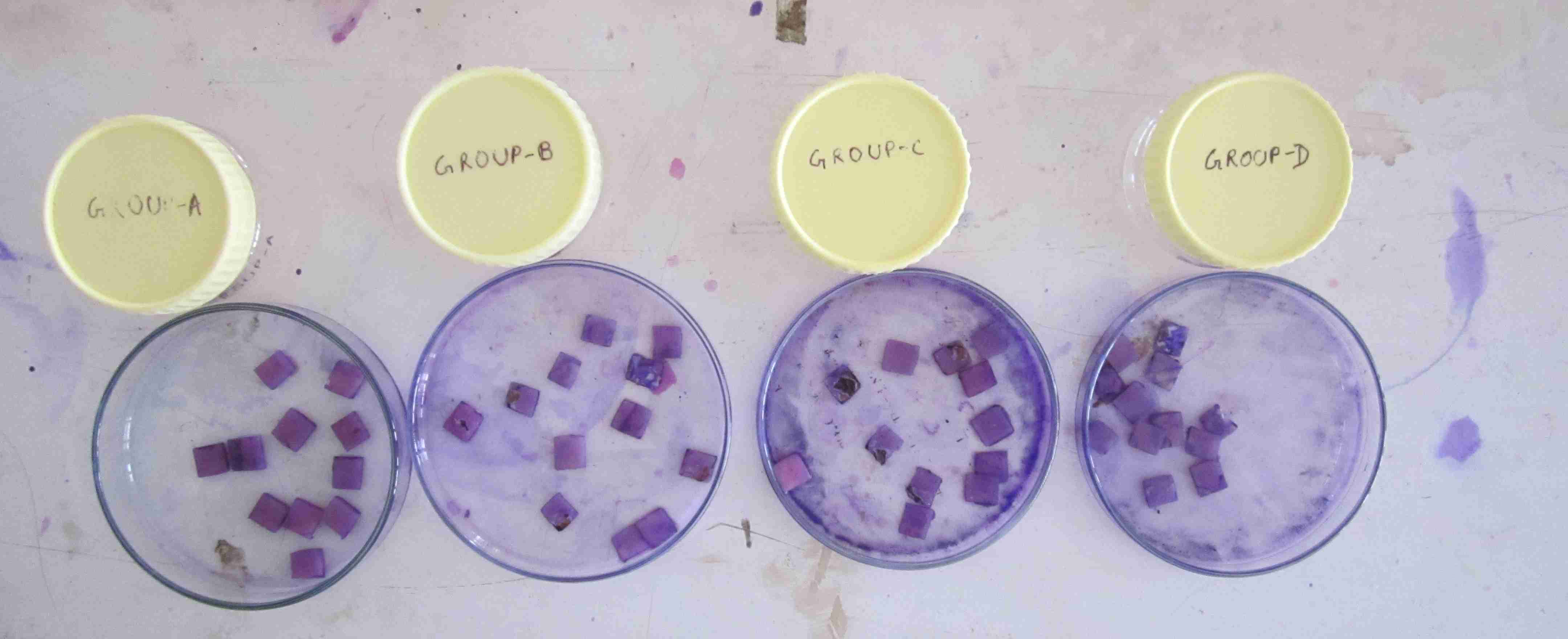
Candida under microscope (40x magnification)
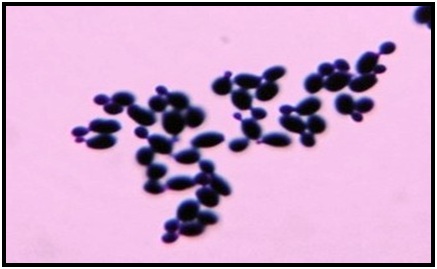
Results and Statistics
[Table/Fig-6] shows descriptive analysis: Dependent variable – adherence of Candida. [Table/Fig-7] depicts mean adherence values of all the four groups. The highest mean adherence value was seen with the Group D and the lowest mean adherence value was seen with the Group B. Group A and Group C showed intermediate adherence values, with Group A showing greater values than the Group C.
*Descriptive statistics showing candidal adherence in control Group A and other test groups B,C.,D
| Groups | n | Mean | Std.deviation |
|---|
| A | 12 | 2.9167 | .79296 |
| B | 12 | .5000 | .52223 |
| C | 12 | 2.5000 | .67420 |
| D | 12 | 37.1667 | 9.16350 |
| Total | 48 | 10.7708 | 16.06270 |
Comparison of adherence of Candida albicans in cells/mm2 over the surface of acrylic specimens between different groups
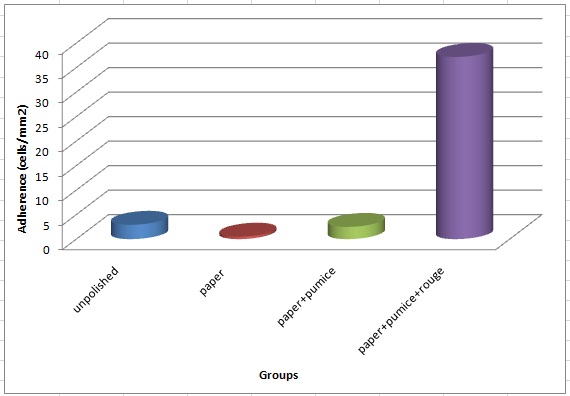
Discussion
Rough surfaces of dentures allow food and other debris to cling to them. Irregular surfaces are likely to occur unavoidably during the construction of an appliance. Irregularity can be avoided by proper finishing of dentures, which involves both abrading and polishing.
The most commonly used materials for finishing and polishing of dentures in day to day practice are: emery papers, rouge and pumice. So, the polishing agents which were used for polishing specimens in the present study were emery papers of grits 320,400,600 respectively, pumice and rouge [1,4].
An important prerequisite for a successful Candidal colonization and infection is the ability of the yeast cells to adhere to the superficial epithelial cells as well as fitting surfaces of dentures [6]. As per authors, both free energy and the roughness of intra–oral hard surfaces have a major impact on the initial adhesion and retention of oral micro organisms [7]. So, the present study was aimed to find out whether polishing, which altered surface roughness could affect adherence of Candida albicans. In the present study, the efficacies of various polishing steps of a polishing protocol for inhibiting the adherence of Candida on surface of heat cure denture base resins were tested. It was found that control group specimens, Group A, which were unpolished, showed a significantly higher adherence of Candida than the Group B and Group C [Table/Fig-8].
*Inter–group comparison of significance between Groups A,B,C and D
| Inter Group Comparision | Level of Significance (p– value) |
|---|
| A-B | .000 |
| A-C | .179 |
| A-D | .000 |
| B-C | .000 |
| B-D | .000 |
| C-D | .000 |
The results which were obtained were in accordance to findings of Donnel et al, who compared inter–procedural variations by using three polishing systems i.e., conventional, acrylic polishing system and silicone polishing system to polish heat cure acrylic specimens. It was found that conventional polishing with the use of carbide bur, sand paper, pumice slurry and Tripoli produced most superior surfaces [8]. Group C showed a marginally lower adherence than control Group A, that was not statistically significant, but adherence in group C was higher than that in Group B [Table/Fig-8]. Where the specimens were polished only by using sand papers. This result was in accordance to the findings of Srividya et al., who showed that surface roughness of acrylic specimens which were polished with pumice slurry produced significantly rough surfaces as compared to metallic polishing liquid and polishing paste, due to loose and larger particle sizes of the pumice. But the polishing agent which was used in this study was only pumice and not sandpaper, followed by pumice [9]. In the present study, adherence of Candida was found to be maximum in test group, where polishing was done by using sandpaper, followed by pumice and rouge (Group D). Moreover, the adherence of Candida increased more than that of the control group (Group A). These results may be due to- interaction between the rouge and Candida such as to have such a significant Candidal adhesion. Candida albicans requires iron for metabolism. Iron is also present in rouge, which is present over the surface of acrylic after polishing, that needs to be removed. This rouge could have increased the adherence of Candida albicans on denture base [9,10,11]. Candida albicans expresses very similar systems of iron uptake as Sacharomyces cerevisiae. C. albicans efficiently uses haem as a nutritional source of iron by secreting haemolytic factors to break down haemoglobin. It is broken down by haem oxygenase [11].Thus, iron is needed for metabolism of Candida albicans. Iron is also present in rouge, which is present over the surface of acrylic after polishing. As it contains wax or grease as a binder [12], it leaves deposits on the work, that after buffing must be cleaned off [10]. Thus, iron from rouge may be used by Candida for its metabolism, which may cause increased cell counts.
Limitations of The Study
Though the Candidal adherence is on the tissue surface, it was not considered here, as the polishing was not done on tissue surface, and as saliva was not used [13,14]. Further, excessive dependence on finishing and polishing procedures for obtaining smoothness of dentures results in reduction of thickness of dentures, that affects the strengths of dentures. So, other ways such as proper wax up, flasking and processing should be emphasized, that produce smooth surfaces without affecting thickness of dentures.
Other limitations such as metal denture bases and other type of denture base materials were not used in this study. Research needs be done, to describe in detail the effect of rouge on Candidal adherence.
Conclusion
Within the limitations of this in vitro study, it can be concluded that:
Finishing specimens of heat cure denture base resin with sand paper of progressive grits alone exhibited minimum Candidal adherence. It was followed by finishing specimens of heat cure denture base resin by using sand paper of progressive grits and polishing with pumice, which reduced Candidal adherence marginally as compared to that in control group. Finishing specimens of heat cure denture base resin by using sandpaper of progressive grits, followed by polishing with pumice and rouge showed maximum Candidal adherence. Therefore, it may be suggested that the specimens which are polished with rouge must be cleaned with solvent to remove residual rouge which remains on the denture surfaces.